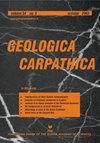Đurđevac砂和地层内古土壤(波德拉维纳,克罗地亚北部)的年代为晚更新世/全新世
IF 1.5
4区 地球科学
Q4 GEOSCIENCES, MULTIDISCIPLINARY
引用次数: 0
摘要
:德尔杰瓦茨金沙是指克罗地亚北部德拉瓦河以南的一个广阔的沙质地区,在那里形成了独特的风成沙丘。迄今为止,它们的年代地层位置是基于地层推断(叠加),没有数字和绝对年龄控制。最近在一个废弃的沙坑(Draganci)中发现了风积沙丘沙下方和上方的埋藏双重古土壤,这使得能够确定德热瓦茨沙的第一个绝对日期。野外观测和实验室分析表明,这些古土壤的成土发育程度很低。它们似乎属于芳烃土壤类型,这也是该地区最近的主要土壤类型。对古土壤中木炭的14C分析表明,它们是在Bølling–Allerød中层之间发育的,大约在14.7 ka到12.9 ka之间,而之前的说法是,它们的年龄完全是全新世。因此,这表明有必要对德尔杰瓦茨金沙进行详细调查。在晚冰川和全新世期间,沙子和古土壤可能经历了一系列景观稳定和不稳定的交替阶段。众所周知,这种事件也发生在喀尔巴阡山盆地的其他沙质地区。本文章由计算机程序翻译,如有差异,请以英文原文为准。
Đurđevac Sands and the intraformational paleosoils (Podravina, N Croatia) are newly dated to Late Pleistocene/Holocene
: The Đurđevac Sands refer to an extensive sandy region south of the Drava River in northern Croatia, where it builds distinctive aeolian dunes. To date, their chronostratigraphical position has been based on stratigraphical inferences (superposition) without numerical and absolute age control. The recent discovery of a buried double paleosoil below and above aeolian dune sands in an abandoned sandpit (Draganci) have allowed the determination of the first absolute dates of the Đurđevac Sands. Field observations and laboratory analyses indicate that the degree of pedogenetic development of these paleosoils is very low. They appear to belong to the arenosol soil type, which is also the dominant recent soil type in the area. 14 C analysis of charcoal from the paleosoils indicated their development during the Bølling–Allerød interstadial, approximately between 14.7 ka and 12.9 ka, as opposed to previous claims that they would be exclusively Holocene in age. Therefore, this shows the need for a detailed investigation of the Đurđevac Sands. The sands and paleosoils likely witnessed a series of alternating phases of landscape stability and instability during the Late Glacial and Holocene. Such episodes are known to have occurred in other sandy regions of the Carpathian basin as well.
求助全文
通过发布文献求助,成功后即可免费获取论文全文。
去求助
来源期刊

Geologica Carpathica
地学-地球科学综合
CiteScore
2.40
自引率
23.10%
发文量
26
审稿时长
>12 weeks
期刊介绍:
GEOLOGICA CARPATHICA covers a wide spectrum of geological disciplines including geodynamics, tectonics and structural geology, volcanology, stratigraphy, geochronology and isotopic geology, karstology, geochemistry, mineralogy, petrology, lithology and sedimentology, paleogeography, paleoecology, paleobiology and paleontology, paleomagnetism, magnetostratigraphy and other branches of applied geophysics, economic and environmental geology, experimental and theoretical geoscientific studies. Geologica Carpathica , with its 60 year old tradition, presents high-quality research papers devoted to all aspects not only of the Alpine-Carpathian-Balkanian geoscience but also with adjacent regions originated from the Mediterranean Tethys and its continental foreland. Geologica Carpathica is an Official Journal of the Carpathian-Balkan Geological Association.
 求助内容:
求助内容: 应助结果提醒方式:
应助结果提醒方式:


